Content for TS 23.282 Word version: 19.2.0
1…
5…
6…
6.6…
7…
7.4…
7.4.2.1.10…
7.4.2.2…
7.4.2.5…
7.4.2.8…
7.4.3…
7.5…
7.5.2.1.12…
7.5.2.2…
7.5.2.4…
7.5.2.6…
7.5.2.8…
7.5.2.11…
7.5.2.14…
7.5.3…
7.6
7.7…
7.7.2.1.13…
7.7.2.2…
7.8…
7.9…
7.13…
7.13.3.1.19…
7.13.3.2…
7.13.3.8…
7.13.3.16…
7.13.4…
7.14…
7.14.2.2…
7.17…
7.17.2.13…
7.17.3…
7.17.3.1.4…
7.17.3.2…
7.17.3.2.4…
7.17.3.2.6…
7.17.4…
7.17.6…
A…
B…
7.13.3.2 Retrieve a stored object
7.13.3.3 Search stored objects
7.13.3.4 Update a stored object
7.13.3.5 Delete a stored object
7.13.3.6 Synchronization
7.13.3.7 Create a user account
...
...
7.13.3.2 Retrieve a stored object p. 181
7.13.3.2.1 General p. 181
A stored object can be retrieved from the MCData message store with the known object identifier that is generated by the MCData message store when the object was deposited.
7.13.3.2.2 Procedure p. 181
The procedure in Figure 7.13.3.2.2-1 describes the case when a message store client retrieves a stored object from the MCData message store using the known object identifier.
Pre-conditions:
- A successful authentication and authorization have been performed between the message store client and the MCData message store.
- The message store client knows the object identifier of the stored object.
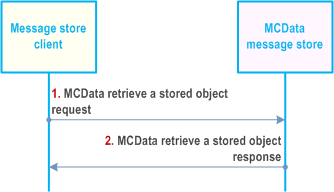
Step 1.
The message store client would like to retrieve a stored object from the MCData message store and initiates a MCData retrieve a stored object request toward the MCData message store. The unique object identifier of the stored object is included in the request.
Step 2.
The MCData message store returns the stored object that is identified by the object identifier in the MCData retrieve a stored object response.
7.13.3.3 Search stored objects p. 182
7.13.3.3.1 General p. 182
The message store client can search stored objects in the MCData message store with certain criteria. This procedure allows the message store client to look for stored object(s) without knowing the object identifier(s) of the object. This procedure also allows the message store client to retrieve stored objects that are related to each other; such as all messages and files exchanged in a conversation.
7.13.3.3.2 Procedure p. 182
The procedure in Figure 7.13.3.3.2-1 describes the case when a message store client searches and retrieves relevant stored objects from the MCData message store.
Pre-conditions:
- A successful authentication and authorization have been performed between the message store client and the MCData message store.
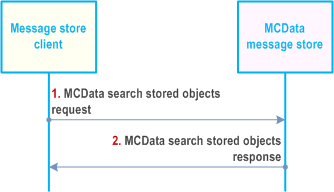
Step 1.
The message store client would like to retrieve stored objects that meet certain criteria (such as with the same Conversation identifier) and initiates a MCData search objects request toward the MCData message store. The search criteria are included in the request.
Step 2.
The MCData message store looks up all stored objects that meet the search criteria and returns them in the MCData search objects response.
7.13.3.4 Update a stored object p. 183
7.13.3.4.1 General p. 183
The message store client can update the metadata of a stored object (such as mark a stored object as "flagged").
7.13.3.4.2 Procedure p. 183
The procedure in Figure 7.13.3.4.2-1 describes the case when a message store client updates metadata of a stored object in the MCData message store.
Pre-conditions:
- A successful authentication and authorization have been performed between the message store client and the MCData message store.
- The message store client knows the object identifier of the stored object.
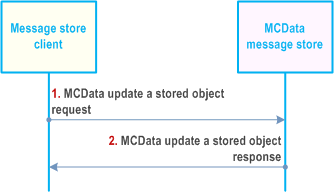
Step 1.
The message store client would like to update the metadata of a stored object (such as "flagged") and initiates a MCData update a stored object request toward the MCData message store. The stored object's object identifier and the updated meta data are included in the request.
Step 2.
The MCData message store locates the stored object with the object identifier and updates its metadata as carried in the MCData update a stored object request and communicates the result in the MCData update a stored object response.
7.13.3.5 Delete a stored object p. 184
7.13.3.5.1 General p. 184
The message store client of an authorized user can delete a stored object in the MCData message store.
7.13.3.5.2 Procedure p. 184
The procedure in Figure 7.13.3.5.2-1 describes the case when a stored object in the MCData message store is deleted by the message store client of an authorized MCData user.
Pre-conditions:
- A successful authentication and authorization have been performed between the message store client and the MCData message store.
- The message store client knows the object identifierof the stored object.
- The MCData user is authorized to delete the stored object.
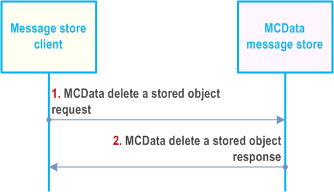
Step 1.
The message store client would like to delete a stored object in the MCData message store and initiates a MCData delete a stored object request toward the MCData message store. The stored object's object identifier is included in the request.
Step 2.
The MCData message store locates the stored object with the object identifier and permanently removes it from the MCData message store. It then communicates the result in the MCData delete a stored object response.
7.13.3.6 Synchronization p. 185
7.13.3.6.1 General p. 185
The message store client can synchronize its local message store with the MCData message store. Different level of synchronization shall be supported with a filter in the request.
7.13.3.6.2 Procedure p. 185
The procedure in Figure 7.13.3.6.2-1 describes the case when a message store client synchronizes its local message store with the MCData message store for a MCData user.
Pre-conditions:
- A successful authentication and authorization have been performed between the message store client and the MCData message store.
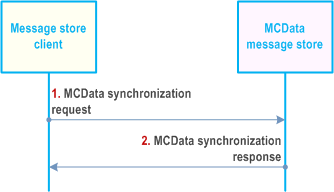
Step 1.
The message store client would like to synchronize its local message store with the MCData message store. It initiates the MCData synchronization request toward the MCData message store. The synchronization type and optional filter criteria are included in the request to indicate the type of synchronization (such as full synchronization, partial synchronization etc.) is requested.
Step 2.
The MCData message store returns all the stored objects, based on the synchronization filter criteria, to the message store client in the MCData synchronization response.
7.13.3.7 Create a user account p. 186
7.13.3.7.1 General p. 186
When the MCData server is ready to deposit an object into the MCData user's storage area in the MCData message store the MCData user's storage area (i.e. user account) needs to be created already. If the user account is not created, the MCData server shall create the user account (i.e. allocate the MCData user's storage area in the MCData message store) first and then deposit the subsequent MCData communications.
7.13.3.7.2 Procedure p. 186
The procedure in Figure 7.13.3.7.2-1 describes how the MCData server creates a user account (allocate MCData user storage area) in the MCData message store.
Pre-conditions:
- A successful authentication and authorization has been performed between the MCData server and the MCData message store.
- No storage area in the MCData message store has been allocated for the MCData user; i.e. no user account has been created.
- The MCData server is authorized to create user accounts on the MCData message store.
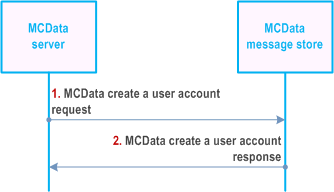
Step 1.
The MCData server would like to create a MCData user account in the MCData message store to store the MCData communication for that MCData user and initiates a MCData create a user account request toward the MCData message store. The MCData ID of the MCData user is included in the request.
Step 2.
The MCData message store creates a user account (i.e. allocate dedicated and secured storage area) for the MCData user as specified in the request and communicates the result back to the MCData server in the MCData create a user account response.